Professor Vooris was extremely informative especially in a subject that I personally do not have much experience in. I have known how political food could be but the DTWOF had an extremely unique take on the politics of food especially with a feminist lens. Something completely new to me that Professor Vooris introduced was the sexuality and heteronormativity of numerous stock photos on the internet that I have never thought about before. These stock photos may not seem very important but if they are being used by the millions all over the internet, they can completely shape a conversation around heteronormativity as well as the sexualizing of women specifically as it relates to food.
Month: February 2020 (Page 6 of 8)
I thought that it was very interesting to learn about the connection between environmental concern and lesbian communities and how that related to food. Choosing to be vegan or vegetarian connotes a specific ethic and aligns oneself with non-violence and challenges a pervasive existing food structure and norms which goes along with the queer lens we talked about in class. Food is used, in a reclamation of the domestic sphere, as a way to proclaim one’s values and identity.
Professor Vooris’s presentation in class today taught me to look at food history and culture from another perspective. I was not previously familiar with this perspective on food culture so it was interesting for me. I also really enjoyed reading the texts in preparation for the discussion today and I am surprised that DTWOF was published so long ago. I am interested in learning more about the intersections between gender identity and food culture specifically from a non-american or non-western perspective.
Today we talked about food, gender, and sexuality with Prof. Yooris. We discussed the article “Lesbian Potlucks” and the comic series “Dykes To Watch Out For.” I don’t know much about lesbian culture so I learned a bit today about some stereotypes. I found the theory of homonormativity to be very interesting. The idea is that same-sex couples are the same as hetero couples, but that this idea upholds harmful institutions anyway. For example, the nuclear family would have a mother, father, son, and daughter. Swapping out the father for another mother does not challenge the idea that a family must be two parents with two children. Rather, we must also recognize the possibility for other family types such as those that sleep in separate beds, those without children, single parents, poly families, etc.
How have you come to understand the function of your family’s ranch?
Is the cattle ranch intended for subsistence consumption or commercial use?
Do you find that you associate your concepts and values of a family with your experiences on the ranch?
What were some of the most surprising parts of working on the farm?
What are some noticeable differences in ‘nature’ from Mexico compared to the United States? What are some not-so-noticeable differences?
Are there concerns in your family over climate change? Other challenges?
Do the daily tasks on your family’s ranch involve more machinery or manual labor? Have there been pressures to switch a certain way?
Who was your favorite cow? Why?
What were your top 3 moments where you felt uncomfortable or scared? Grossed out?
Would you say cows have distinctive personalities? Serious answers only, please.


[gview file=”http://blogs.dickinson.edu/food-experience/files/2020/02/Food-Production-Interview.pptx”]
I was very interested in the community that food producers shared here in the Carlisle area, and Jenn Halpin shed light on that community by sharing her amazing experiences of establishing the Dickinson Farm. She explained the construction of a business plan which led to the creation of the farm on land the college owned and rented to other farmers. She built the farm program from the ground up by reshaping the land and finding the resources to provide the infrastructure for the farm to run. Initially the farm was focused on production in order to make the program viable to continue into the future. However, over time and through serious dedication it has continued to evolve into both a crucial educational and food system for the college. She expressed to me some difficulties through her tenure as director of the farm both due to a view of the subsidies the farm receives from the college by other farmers, but also prejudices she faces in a traditionally male dominated industry. However, she has proven her success as a leader and farm manager over the last decade and continues to make the farm an important part of the Dickinson and Carlisle communities as director. 
I interviewed Lynne Morgan at Farmers on the Square about Whistleberry Farm, the farm she and her husband run, in order to connect further with a local farmer that I have met a couple of times and learn more about fungiculture, one of my personal interests. I found it so interesting that the Morgan’s farm started as a hobby and has grown so much but that Lynne and her husband both still have full time jobs while managing the whole operation themselves. The amount of work they must put into the farm is impressive considering she herself considers the farm to be a full-time job in addition to their other work, and they have grown the business a lot despite this challenge. They started at their old house, where they wanted to grow something but lived in a forest, so mushrooms seemed like a good choice. From there, they expanded into beekeeping and had scaled up enough to start going to farmers markets. It was great to hear how important their base of loyal customers is, and Lynne mentioned that her and her husbands families have bother been so supportive. Since moving to their farm, they have expanded further by growing many kinds of produce. They grow mushrooms throughout the year, and I was surprised to learn that they even grow shiitake indoors despite shiitake being typically grown on logs and them having thousands of logs on their property for growing mushrooms. We had a short but very interesting conversation after the interview about specific growing practices for mushrooms that opened my eyes to the different approaches one can take.
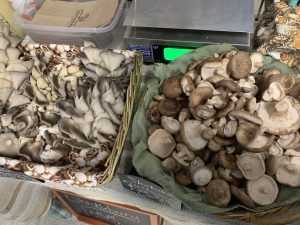


I interviewed Ploughman Cider at their Farmers on the Square stand for my food producer snapshot. I learned a lot about the production and retail of their cider and got to try some samples! Snapshot
I interviewed Mel from Keswick Creamery at Farmer’s on the Square this past week. It was a really insightful and enjoyable interview! I learned a lot about dairy farming, her business, and what it’s like to be a dairy farmer in Central PA. The link below shows my snapshot of Keswick Creamery – Mel referred me to their Facebook page and website for photos of their cows and farm. In the snapshot are some of my favorites, plus her wonderful cheese display at Farmer’s on the Square.
[gview file=”http://blogs.dickinson.edu/food-experience/files/2020/02/Local-Snapshot-Keswick-Creamery.pdf”]
[gview file=”http://blogs.dickinson.edu/food-experience/files/2020/02/Celtic-Knot-Farms-Presi-1.pptx”]
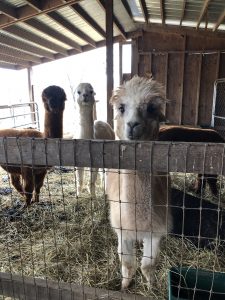

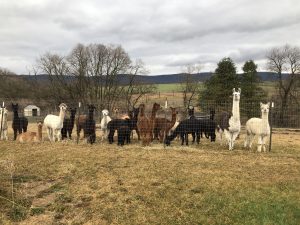
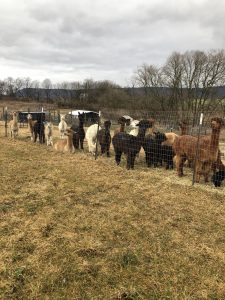
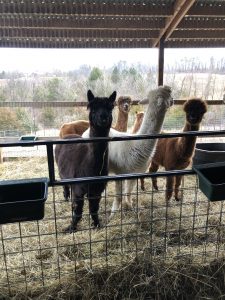
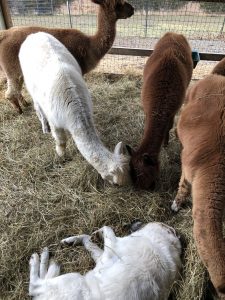
This past week I visited Russell Jones at the Celtic Knot Alpaca farm which is right down the road about 10 minutes from campus. Russ runs the farm with his sister Rebecca Jones and they have a pack of 40 alpacas with 1 Llama, for protection. Russ primarily runs the day to day operations on the farm. All of the animals are raised for their wool only. Russ was mainly discussing the business aspects of his operation such as how he processes the wool as well as the co-ops that Celtic Knot are a part of in order to maintain as close to profitiability as possible.
Russ seemed particularly prideful about the fact that the Jones family produces their final product from start to finish and it is all hand-made, however this makes the products slightly more expensive than imported products which Russ mentioned was one of the difficulties of running the business-side of the farm. However I was thought it was particularly unique that for every animal that is on the farm, there is carefully documented genetic information to prove that all of the animals were raised by Russ, and to the genetics of their color.
One of the most major obstacles that the farm faces is the zoning of the piece of land that the family owns. Russ would like to expand his fenced in pastures, yet there is a marsh that flows into a creek that divides part of the property. Russ continued to explain that this particular creek is under a reforestation program through the State, therefore it limits what he can do to his own land. However, the land nearest to this creek turns out to be shale which he commented makes it nearly impossible to plant anything. This creek also requires Russ to have a bridge on his property to transport the herd to different pastures as well as a bridge strong enough to hold a tractor. These are some of the main issues Russ faces when planning for the future especially increasing the size of the herd to increase profitability.
Lastly, Russ discussed at length the fact that Alpacas and Llamas are very low maintenance animals to farm which makes them so popular especially in this area for farming enthusiasts. The animals are relatively low cost, relatively healthy, and even quiet (unless a predator is present). I was previously unaware that in the surrounding counties, there are probably 20-30 alpaca herds, Russ’s being the largest. Considering this fact, it allows Russ to make extra business by shearing for other farms and even purchasing wholesale fibers that small herd owners cannot really use because of the small amount. Russ uses the wholesale fibers to blend in with his own, (if the fibers are similar enough) to make the threshold weight at a mechanized processor.
I did not know much about Alpacas before this but Russ was beyond welcoming, informative, and knowledgeable. Celtic Knot Farms seems to run a tight-ship and all of the animals themselves were friendly and clean. Russ also has various cats roaming the farm that have helped socialize the Alpacas along with a big dog that lives with the males. The Llama in the pack of females (Sadie) is for protection, hence her large size, from predators such as coyotes. The dog with the males usually acts as protection, but Russ said that the males are typically aggressive towards natural predators and thus he worries about them less.
Recent Comments